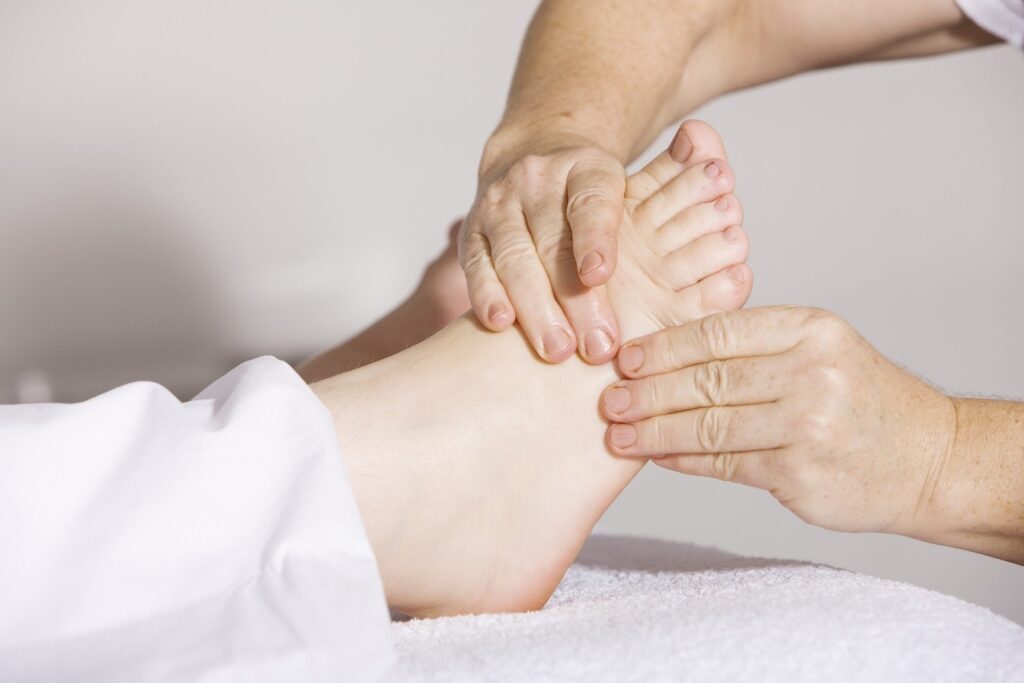
By Rebecca McKinsey
Guy LoPresti has to measure every step he takes—because he knows he’ll pay for it later.
For three decades, the 59-year-old resident of Lodi, New Jersey has lived with not only diabetes but also peripheral neuropathy, a complication that affects as many as 50% of people with diabetes.
Peripheral neuropathy is a type of nerve damage that, among people with diabetes, can develop when high blood sugar injures the nerves. It affects the extremities—in diabetic cases, most often the legs and feet.
Guy has lost feeling in his feet up to his knees, his hands up to his wrists, and his penis and buttocks.
Because of severe diabetic ulcers, Guy needed a transmetatarsal amputation on his right foot—essentially removing the front portion of the foot—and has had one toe on his left foot amputated. His physicians have said they’ve never seen a more severe case of neuropathy.
“It has destroyed my life,” Guy said. “Every day I’m on borrowed time. Say I’m at a family gathering where there’s dancing—if I do that, I have to pay the price. It’s terrible.”
Guy takes gabapentin and naproxen and avoids certain foods like melon, pasta, and cake, which immediately aggravate his nerve pain. He meditates regularly. Arm braces help take some of the weight off his feet, and he uses specialized orthotics.
A classically trained pianist, Guy can no longer perform at parties, restaurants, and bars because of the loss of feeling in his hands. He sometimes teaches lessons, but only on days when he is not “writhing in pain,” he said.
Peripheral neuropathy is unique in that many people who live with this condition experience pain on top of the loss of sensation.
“It feels like somebody’s sticking a nail in my big toe, which isn’t even there,” Guy said, who describes his pain as alternately burning and stabbing.
Numbness, pain, and undetected injuries
Lack of sensation means people with peripheral neuropathy can injure or burn their hands or feet and not realize it, said Dr. Charles Argoff, an attending neurologist at Albany Medical Center. Dr. Argoff directs the center’s Comprehensive Pain Program and Pain Medicine Fellowship and is a professor of neurology at Albany Medical College.
“In diabetic neuropathy, if you don’t have normal sensation, you step on something and start bleeding and don’t feel it—if the neuropathy is severe enough, your body doesn’t communicate it to the brain,” Dr. Argoff said.
“We tell people to be careful, because they may not know that they have this degree of loss of sensation and may not realize they need to look out for this.”
Prevention and treatment
Managing diabetes helps prevent and manage neuropathy. Dr. Argoff recommends patients keep lipids low and hemoglobin A1C levels below 7 if possible.
“Try to find a provider or a team of providers who assertively evaluate you, and recognize there are a variety of medical approaches to treatment that can be considered,” he said.
He referenced two recently-approved treatments for diabetic neuropathy: Qutenza, a topical medication that can treat diabetic nerve pain in the feet, and Nevro HF10 spinal stimulation, which delivers electrical pulses to the nerves to stop pain signals that are sent to the brain.
Making new strides
Rick Phillips has type 1 diabetes and has been living with peripheral neuropathy for about 30 years.
He experiences loss of sensation and “horrific shooting pains” in his feet that come and go.
For Rick, 64, who lives near Indianapolis and is very active, a major complication of his neuropathy is how it affects his balance. Walking poles have been a big help.
Rick’s mother also had diabetes and neuropathy, causing her to regularly break the bones in her feet. She died at the age of 48, a poignant fact for Rick, who has lived with diabetes for 47 years.
His mother’s experience with neuropathy has made him extra careful. He wears shoes almost all the time, even inside, to ensure he doesn’t step on something and injure his foot without feeling it.
“I check my feet—if not every day, at least every other day—to see if there’s a sore, and if there is, that’s like a five-alarm emergency for me,” Rick said. “We have to get it fixed.”
His care team includes a certified diabetes educator, endocrinologist, podiatrist, neurologist, and a physician who treats Rick’s rheumatoid arthritis and also keeps an eye on his feet.
“Keeping my feet healthy, it’s really a group effort, and it requires many specialists to get things right,” he said.
And that care extends to his diabetes as well.
“Diabetes is a constant 24/7 disease,” Rick said. “It is overwhelming. And it impacts every single part of your life. But it is manageable, it is treatable, and we’ve made great strides.”
Learn more about neuropathic pain and U.S. Pain’s 2021 KNOWvember campaign.
This campaign was created through support from Axogen, Inc. and Vertex Pharmaceuticals. U.S. Pain Foundation developed the content without review from sponsors. This information is educational only and should not be used as a substitute for advice from a health care professional.
